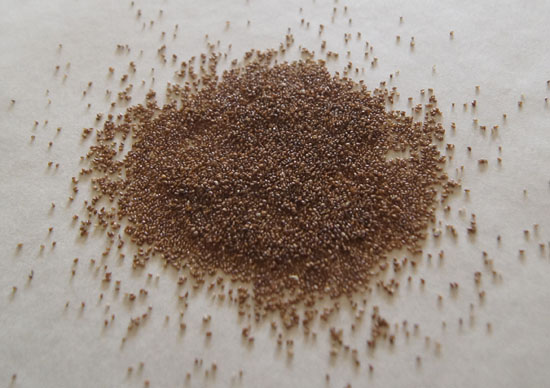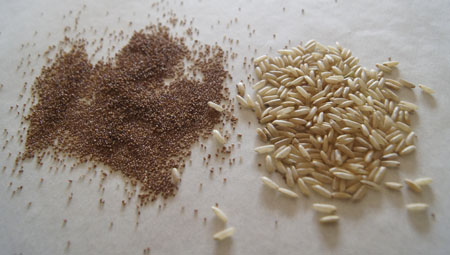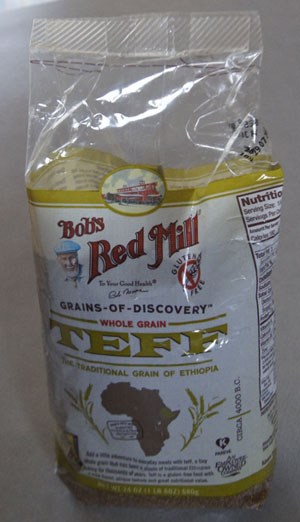Traveling through the web searching for information on millet for the Grains section of my blog, I came across this book by a woman called Lorna Sass: Whole Grains Every Day, Every Way. Just who is this woman? I preview parts of the cookbook and decide that I must have it. Shall I purchase Whole Grains Every Day, Every Way as an e-book or hard copy? My thoughts follow. First, let’s meet Lorna Sass, then I’ll ramble about e-books.
Lorna Sass
I learned about Lorna Sass while reading the Whole Grains Council section on millet. She is one of their culinary advisors, as listed on this web page. Whole Grains Council (WGC) has a bio page for Lorna Sass, where I learn that she is a widely published food writer and an award-winning cookbook author. I follow their link to her website and read more of her biography. Sass begins her bio with “my mom was a good cook, and a very adventurous one” and that she “grew up with a relaxed sense of cooking good food”. She did not begin her career as a food writer, no, she graduated from Columbia University with a PhD in medieval literature. During her studies, serendipity led her to a 1390 book of recipes from the royal household of Richard II. Aha! A woman after my own heart – she checked out the book and started cooking the recipes!
She did not stop with just cooking the recipes. She wrote To the King’s Taste and three other books on the history of cooking. Quote from her website: “During the 70s, I gave lectures and taught workshops on the history of gastronomy all around the country.”
And then, Sass became interested in pressure cooking when in the 1980s her “mom brought a pressure cooker back from India and started turning out delicious soups and stews in 15 minutes”. Four pressure cooking books resulted! She calls Pressure Perfect her definitive word on the subject. I too became interested in pressure cooking, but in the 1970s. (Presto Pressure Cooker Recipe Book, a 250 Cookbooks blog post.)
Sass also notes that she was a vegetarian for “about a decade”. As you might guess by now, that led to another four cookbooks. She also mentions her love of travel and photography. (Her Facebook page has some great photos.)
I enjoyed learning about one more great cook who is fascinated by food, likes to try new things, steers toward whole grains and home cooked meals, and writes cookbooks. Sass has a presence on Facebook and a blog. More about her story is found on her WordPress “about” page.
Hard copy or e-Book?
All of my current cookbooks are hard copy publications. I like sitting in a comfy chair and perusing recipes and stories and photos of food. I like writing notes in the books or inserting hand-written post-its to mark ideas and suggestions. Can I really sit down with a book that is on my iPad or computer instead of paper? There is something about turning the pages of a printed, paper book that is comforting.
E-books might work for me, though. I could access an e-book from my phone, my iPad, and my computer. I could be in a store and look up a recipe so I know what I need to by. Or, I could sit in a chair with the iPad or my MacBookPro and swipe through the pages. Or, I could sit here at my desk with a big screen and all my stuff around me, with access to all of my databases and writings and notes.
And, I could have the e-book immediately. No waiting. No waste of paper, no book to find space for on a shelf. The e-book costs less than the printed book. I don’t have to travel to a brick and mortar store and maybe not find it (or pay a lot). I won’t have a lot of packaging to recycle from an online purchase shipment.
All these things considered, plus with a choice to try something new, I decide to try this cookbook as an e-book. The download is quick and voilá, it is on my computer.
How do I like using the e-book?
I have read e-books on occasion, but not a lot, so I need to get familiar with the functions. I’m using the Kindle app on all my devices. So, I start playing around with all of them. I find that I can add a note anywhere in the book. The notes I add on my computer version are synched with both my iPhone and iPad versions, and visa versa. This is very useful!
I like being able to search for a word (e.g., an ingredient) and go directly to that page.
I think I will like this method of using cookbooks. Especially for this cookbook, which is mostly information and recipes – no photos.
How do I like Whole Grains Every Day, Every Way?
Wow. I really like this book. If I had found it sooner, I probably would not have started the Grains section of my blog.
Sass begins with “what is a whole grain”. I am always going on about whole grains when talking to friends and family, and I like having this reference at the ready so I can keep my facts straight. “A kernel of grain is comprised of three edible parts: the bran, the germ, and the endosperm. Some grains have a fourth part – the hull or husk – which is an inedible protective covering.” And “In order to qualify as a whole grain, a kernel must have all three parts intact.” If a grain is processed into pieces, like wheat into bulgur, or any grain into flour, the processed grain must have the same nutrition profile as the kernel to be called “whole grain”, according to USDA guidelines and the Whole Grains Council. Look for the word “whole” in labels of grain products.
In a whole grain, the bran contains dietary fiber, B vitamins, and trace minerals. The germ contains vitamins B and E, essential fatty acids, phytochemicals, and unsaturated lipids. Here is a direct quote from Whole Grains Every Day, Every Way: “The germ is located at one end of the kernel near where the kernel connects to the stalk, since it is just under the bran, if the bran is removed, so is the germ.” The endosperm is the largest portion of the kernel, and contains starch and protein and B vitamins.
Some of the grains she covers are seeds or pseudocereals. For instance, quinoa, amaranth, and millet are not members of the grain family in botanical terms, but are commonly referred to as grains because they are cooked like them and have similar nutritional profiles. I’ve run into this definition before while studying grains for my Grains section of my blog.
Sass methodically studied how to cook each grain. Just like a scientist! She has a section titled “In my kitchen laboratory”. Her kitchen experiments included pre-soaking the grain (or not); putting the grain in boiling water or starting with the grain in cold water and then bringing to a boil; toasting before cooking; adding salt early or late; letting a grain stand covered after cooking; pressure cooking; and adding oil (or not).
Because of all of her cooking trials, I find Sass’s cooking instructions for each grain easy to follow, full of excellent suggestions, and so far, perfect for each grain I’ve tried.
Sass talks about cooking grains in large batches to create your own “grain bank”. Most grains store well in the freezer, and can be frozen in small portions for last minute use. I learned about this method when I wrote my Grains post on kamut from the Food Storage Moms website.
For each grain, Sass tells us what sort of foods they go well with in a compatible foods and flavors section. For instance, amaranth is compatible with savory ingredients such as butter, olive oil, sun-dried tomatoes, mushrooms, oregano, corn, sesame seeds, and fresh ginger, and sweet ingredients such as honey, vanilla, chocolate, cinnamon, banana, and winter squash.
The recipes are all at the end of the book. This is nice in an e-book, because when she mentions the recipe in the text of a grain’s section, it is hyperlinked directly to the recipe.
The “further reading” chapter at the end of the book is wonderful. One link I found that I really like is the USDA Food Composition Databases website. I put it in my browser’s tool bar so I can easily find the nutrition profile of just about any food.
At the very end is a hyperlinked index. This may not be as necessary as in the print version, since you can always do a word search in an e-book.
The only drawbacks to this book is that it was published in 2006, so some of the information might be outdated, and that it does not have photos of grains.
I am happy with my decision to buy the e-book, and I am totally happy that I found and now own Lorna Sass’s Whole Grains Every Day, Every Way.


 Millet compared to medium grain brown rice:
Millet compared to medium grain brown rice: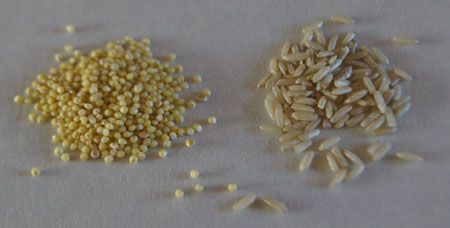
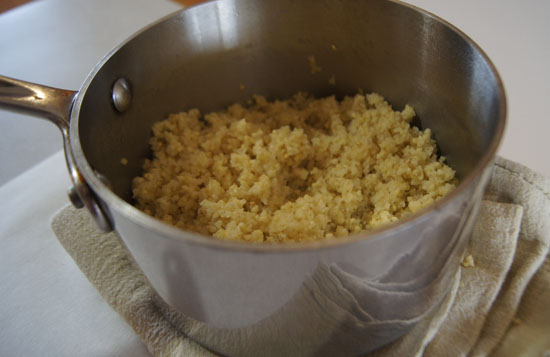 I think it is beautiful! It tastes a tiny bit like corn, and not all the seeds cooked evenly, giving it just about the perfect amount of crunch. (“Crunch” is an important factor in my food tasting!)
I think it is beautiful! It tastes a tiny bit like corn, and not all the seeds cooked evenly, giving it just about the perfect amount of crunch. (“Crunch” is an important factor in my food tasting!)